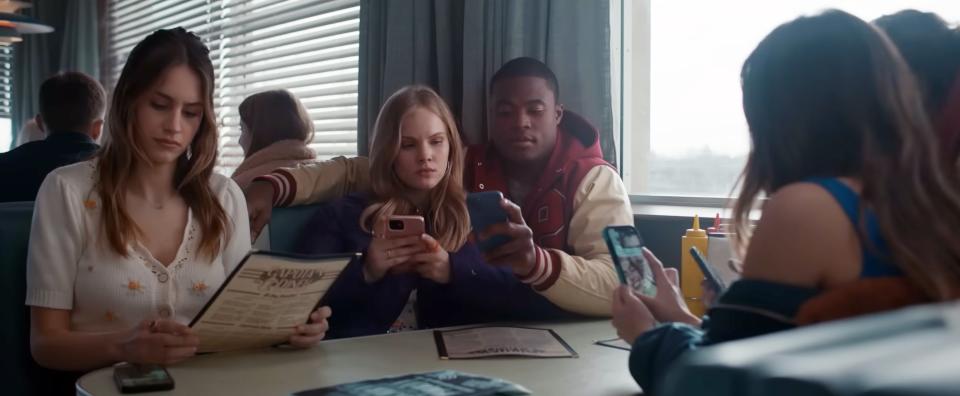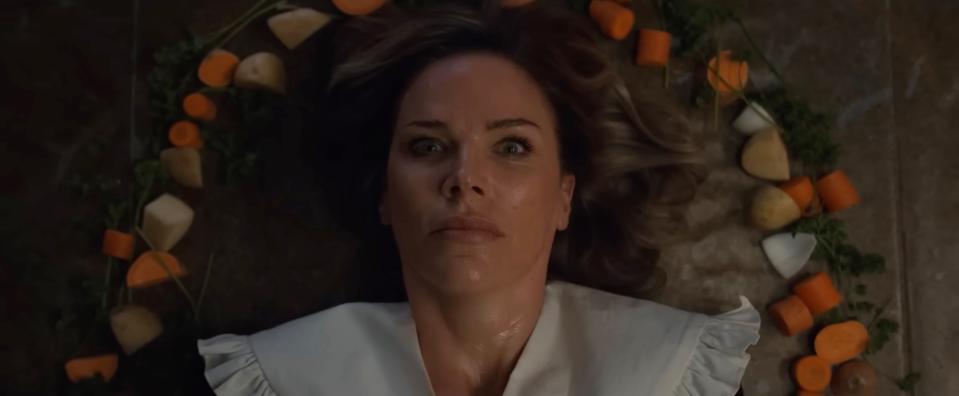‘Thanksgiving’ Slices and Dices Cinematic Influences from Fellini to ‘A Christmas Story’

- Oops!Something went wrong.Please try again later.
- Oops!Something went wrong.Please try again later.
- Oops!Something went wrong.Please try again later.
October is usually thought of as the prime time for horror, but the best horror movie of 2023 — for that matter, the most deliriously entertaining horror movie since Wes Craven‘s original “Scream” — arrives not for Halloween but for Thanksgiving. It’s a movie horror fans have been eagerly anticipating ever since director Eli Roth created a fake “Thanksgiving” trailer for Quentin Tarantino and Robert Rodriguez’s “Grindhouse” in 2007, and the feature version that Roth and writer Jeff Rendell have extrapolated from that hilarious and gory short is well worth the wait. Their “Thanksgiving” is an ingeniously structured, elegantly composed thrill machine. It’s also a gleeful assault on good taste; it’s what you get when a 1970s or ’80s Canadian tax shelter thriller like “Prom Night” or “My Bloody Valentine” is directed by a true artist.
“Thanksgiving” riffs on dozens of slasher favorites from “Black Christmas” and John Carpenter’s “Halloween” to “Silent Night Deadly Night,” and one of the movie’s pleasures for genre fans is Roth’s flawless evocation of the genre’s conventions. Yet he manages to pay tribute to his influences without being constrained by them, in the process creating that rare homage that’s actually better than any of its sources. (Maybe it’s not better than “Halloween,” but it’s the closest anyone has come in decades.) If “Thanksgiving” has a breadth of style and more depth and texture in its characterizations than most of its ancestors, that might be because Roth — like Tarantino and Martin Scorsese, both voracious cinephiles — didn’t limit himself to horror flicks when it came to his reference points.
More from IndieWire
“We use the cinematic language of a slasher film,” Roth told IndieWire’s Filmmaker Toolkit podcast. “I open with a point-of-view shot with the identifying title of where you are and what night it is. ‘The Prowler’ does that. ‘Halloween,’ ‘The Town That Dreaded Sundown.’ But there are other influences in there too.” Roth showed cinematographer Milan Chadima the Federico Fellini short film “Toby Dammit,” which the director considers to be “one of the most beautifully shot films of all time.” The key for Roth was creating a visual style in which every location was as filled with detail as possible. “We wanted every location to be rich and textured and filled. No white walls, no blank walls — there’s no excuse for that. The way you take a low-budget movie and make it look big budget is to really fill your frame.”

Another unexpected influence was Bob Rafelson’s “Five Easy Pieces,” which had an autumnal Americana look that Roth wanted to emulate, particularly in his movie’s diner scenes. “We watched ‘Five Easy Pieces’ for the beautiful Laszlo Kovacs photography,” Roth said. “The fall colors, the oranges, that rich, lush look.” And while Bob Clark’s “Black Christmas” might seem like an obvious touchstone for “Thanksgiving,” Roth revealed that another Clark film was equally instructive when finding a model for the movie’s gruesome dinner sequence. “We looked at ‘A Christmas Story,’ because we’re in a holiday movie that just happens to turn very sick. The movie is about the perversion of the holiday, so it has to look like a holiday movie that gets perverted by the killings.”

Roth also thought outside the box when it came to movies to show his actors. “The actors were like, ‘What should we watch? Should we watch horror films?'” Roth said. He did show his lead actress Nell Verlaque one of his favorite horror movies, “Mute Witness,” but to give everyone an idea of the horrific journey they would be called upon to act out, the director had the ensemble watch William Friedkin’s “Sorcerer.” “I said, look what everyone went through on this movie — I don’t want anyone complaining on set.” Roth also looked outside North America for influences, instructing the actresses in “Thanksgiving” to study the lead performance in Jean-Jacques Beineix’s film “Betty Blue.” “I said, ‘Watch Béatrice Dalle’s performance in that. She was 21 — you’re 22. What’s your excuse? That’s the level I expect.'”
Another Beineix film, “Diva,” served as inspiration for both the visual style and Roth’s approach to the supporting members of the ensemble. “There are no minor characters in that movie,” Roth said, adding that he considers “Diva” to be the birth of modern cinema. “I think you can trace all modern movies back to ‘Diva.’ ‘True Romance,’ the Coen brothers…suddenly cinema changed.” To Roth, there’s nothing incongruous about looking to French art house cinema to find models for a down-and-dirty slasher flick. “For me, slasher films are really the purest form of cinema. It’s cat and mouse, stalking, chasing with no dialogue. It’s this pure cinematic experience where you’re just caught up in the tension. It should look lush, and it should look beautiful.”
Best of IndieWire
Where to Watch This Week's New Movies, from 'The Hunger Games' and 'Saltburn' to 'May December'
The Best Thrillers Streaming on Netflix in November, from 'Fair Play' to 'Emily the Criminal'
Sofia Coppola Movies, Ranked: 'Priscilla,' 'The Virgin Suicides,' 'Marie Antoinette,' and More
Sign up for Indiewire's Newsletter. For the latest news, follow us on Facebook, Twitter, and Instagram.

